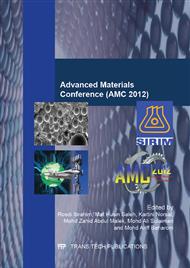[1]
Galan Sanchez, L. M., Meindersma, G. W., and de Haan, A. B., Solvent Properties of Functionalized Ionic Liquids for CO2 Absorption, Chemical Engineering and Research Design, 85 (2007) 31-39.
DOI: 10.1205/cherd06124
Google Scholar
[2]
Galan Sanchez, L. M., Meindersma, G. W., and de Haan, A. B., Kinetics of Absorption of CO2 in Amino-Functionalized Ionic Liquids, Chemical Engineering Journal, 166 (2011) 1104-1115.
DOI: 10.1016/j.cej.2010.12.016
Google Scholar
[3]
Miao, W. and Chan, T. K., Ionic-Liquid-Supported Synthesis: A Novel Liquid-Phase Strategy for Organic Synthesis, Accounts of Chemical Research, 39 (2006) 897-908.
DOI: 10.1021/ar030252f
Google Scholar
[4]
Anderson, J. L., Dixon, J. K., and Brennecke, J. F., Solubility of CO2, CH4, C2H6, C2H4, O2, and N2 in 1-Hexyl-3-methylpyridinium Bis (trifluoromethylsulfonyl) imide: Comparison to Other Ionic Liquids, Accounts of Chemical Research, 40 (2007) 1208-1216.
DOI: 10.1021/ar7001649
Google Scholar
[5]
Anthony, J. L., Anderson, J. L., Maginn, E. J., and Brennecke, J. F., Anion Effect on Gas Solubility in Ionic Liquids, Journal of Physical Chemistry B, 109 (2005) 6366-6374.
DOI: 10.1021/jp046404l
Google Scholar
[6]
Marsh, K. N., Boxall, J. A., and Lichtenthaler, R., Room Temperature Ionic Liquids and Their Mixtures – A Review, Fluid Phase Equilibria, 219 (2004) 93-98.
DOI: 10.1016/j.fluid.2004.02.003
Google Scholar
[7]
Park, S. and Kazlauskas R. J., Biocatalysis in Ionic Liquids – Advantages Beyond Green Technology, Current Opinion in Biotechnology, 14 (2003) 432-437.
DOI: 10.1016/s0958-1669(03)00100-9
Google Scholar
[8]
Riisager, A., Fehrmann, R., Haumann, M., Wasserscheid, P., Supported Ionic Liquid: Versatile Reaction and Separation Media, Topics in Catalysis, 40 (2006) 91-102.
Google Scholar
[9]
Bara, J. E., Hatakeyama, E. S., Gin, D. L., and Noble, R. D., Improving CO2 Permeability in Polymerized Room-Temperature Ionic Liquid Gas Separation Membranes Through The Formation of a Solid Composite With a Room-Temperature Ionic Liquid, Polymers for Advanced Technology, 19 (2008) 1415–1420.
DOI: 10.1002/pat.1209
Google Scholar
[10]
Kuhlmann, E., Haumann, M., Jess, A., Seeberger, A., and Wasserscheid, P., Ionic Liquids in Refinery Desulfurization: Comparison between Biphasic and Supported Ionic Liquid Phase Suspension Processes, Chemistry and Sustainability Energy and Materials, 2 (2009) 969-977.
DOI: 10.1002/cssc.200900142
Google Scholar
[11]
Hong, G., Jacquemin, J., Deetlefs, M., Hardacre, C., Husson, P., Gomes, M. F. C., Solubility of Carbon Dioxide and Ethane in Three Ionic Liquids Based on the Bis{(trifluoromethyl)sulfonyl}imide Anion, Fluid Phase Equilibria, 257 (2007) 27-34.
DOI: 10.1016/j.fluid.2007.05.002
Google Scholar
[12]
Myers, C., Pennline, H., Luebke, D., Ilconich, J., Dixon, J. K., Maginn, E. J., and Brennecke, J. F., High Temperature Separation of Carbon dioxide/Hydrogen Mixtures Using Facilitated Supported Ionic Liquid Membranes, Journal of Membrane Science, 322 (2008) 28-31.
DOI: 10.1016/j.memsci.2008.04.062
Google Scholar
[13]
Gray, M. L., Champagne, K. J., Fauth, D., Baltrus, J. P., and Pennline Henry, Performance of Immobilized Tertiary Amine Solid Sorbents for the Capture of Carbon Dioxide, International Journal of Greenhouse Gas Control, 2 (2008) 3-8.
DOI: 10.1016/s1750-5836(07)00088-6
Google Scholar
[14]
Liu, J., Yang, Q., Zhao, X. S., and Zhang, L., Pore Size Control of Mesoporous Silicas from Mixtures of Sodium Silicate and TEOS, Microporous and Mesoporous Materials, 106 (2007) 62-67.
DOI: 10.1016/j.micromeso.2007.02.045
Google Scholar


